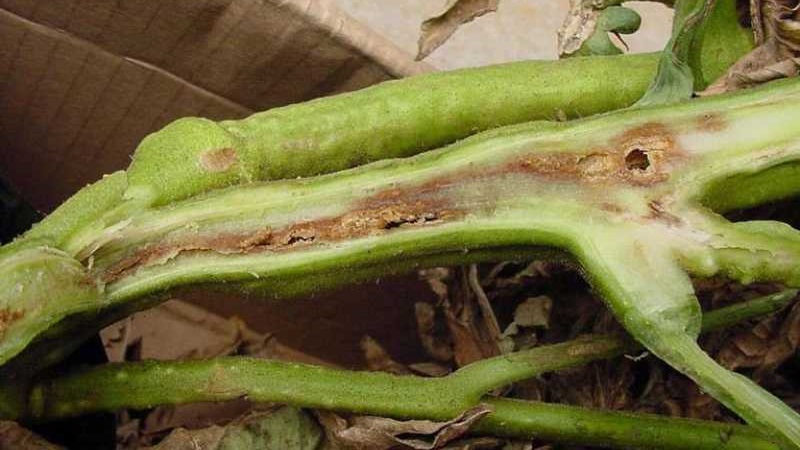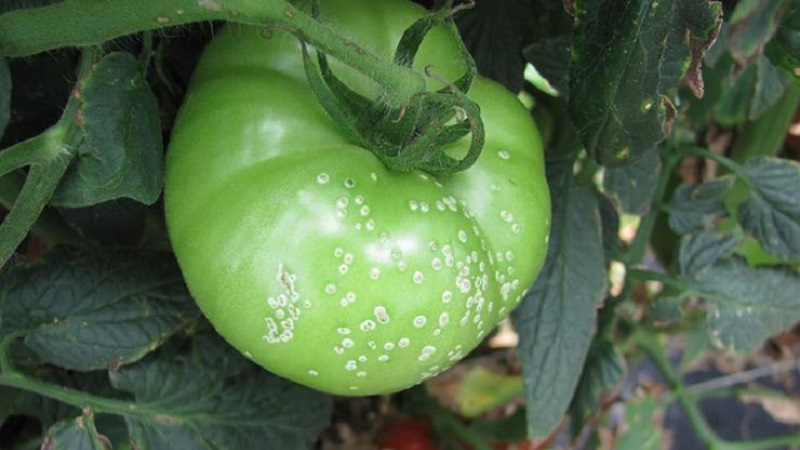What is the danger of bacterial cancer of tomatoes and how to deal with it on your own: folk methods and advice from summer residents with experience
Have you faced a situation where tomatoes grown with such difficulty began to become covered with spots and ulcers? Experienced gardeners know that tissue damage indicates the development of bacterial tomato cancer. What is this disease, how is it transmitted, can it be cured and how to protect the crop? You will learn the answers to questions about plant cancer from this article; photos are attached to the advice of experienced gardeners.
The content of the article
What is this disease
Bacterial cancer is a chronic disease that affects perennial crops: grapes, fruits, berries, and roses. Scientists have found that the causative agents are rod-shaped bacteria. Microorganisms are much more stable in sandy soil, in fertilized soil they can be quickly dealt with. The causative agent of bacterial cancer is very tenacious - it remains in the soil even two to three years after the complete decomposition of the infected fruit.
Failure to comply with agricultural practices and weather conditions contribute to the development of the disease. The disease develops slowly - it can take two months from infection to death of the plant. Tomato bacterial cancer is typical for greenhouses and hotbeds, since they maintain favorable conditions for the life of the pathogen. Mass infection can lead to the death of 30% of the crop, and in advanced cases there is a risk of loss of all plants.

How does it affect tomatoes
There are two types of bacterial cancer: diffuse and local. The first form of development of the disease is considered the most dangerous, it is characterized by damage to the vascular system of the plant. As a result, the stem and leaves begin to wilt, which leads to the death of the seedlings. In the second form, the fruits suffer, in an advanced stage the disease makes them unfit for consumption. Seeds infected plants may contain the causative agent of the disease, so the fruits and the ground part are burned.
Symptoms and external signs
Even a novice gardener can determine the defeat of bacterial cancer. If, however, with the diagnosis of the disease that struck seedlings, difficulties arise, experienced specialists will be able to recognize the disease from photographs. The first symptoms begin to appear two to three weeks after planting seedlings in the ground.
Manifestation of bacterial cancer:
- wilting of leaves on one side of the plant;
- the appearance of black tears on the stems;
- discharge from lesions of mucus;
- damage to the vascular system of the plant - when the leaf is cut, darkening of the vessels is visible;
- covering plants and fruits with dark spots and ulcers.
Infected fruits can be identified initially by tearing them off the calyx. With bacterial cancer, the vascular bundles of tomato will darken. You can also cut a tomato - in case of illness, yellow veins stretch to the seed chambers.

Reasons for the appearance
The cause of the development of the disease is the activity of the rod-shaped bacteria Corynebacterium michiganense. When they get inside the plant, they begin to move, infecting everything in their path.
Important! The plant can get sick at any stage of growth, so you need to monitor the condition of the leaves of the seedlings so as not to miss the development of bacterial cancer.
The causative agent of the disease is very tenacious, it can be transmitted from infected seeds, through the soil, the remains of infected plants and garden tools.
Terms of distribution
The disease is inherent in regions where low temperatures are observed in winter. Perennial crops are damaged during frost and hail. Bacteria penetrate into the places of peridermis rupture, which then spread throughout the plant.
Tomato bacterial cancer most often affects plants grown in greenhouses and greenhouses. Damage to the tomato bush increases the risk of developing the disease. Often the disease is in a latent form, and this is its main danger.
A temperature of +25 C ° promotes the reproduction of bacteria, a critical indicator for their life is +50 C °. Heat and high humidity contribute to the rapid development of cancer. The disease can be transmitted from one plant to another through wind and rain.
Caution! Fruits can become infected through external lesions during secondary spread of the disease.
How and what to treat
With a diffuse form of the disease, the fight does not make sense. The second form of bacterial cancer is treatable - the crop can be saved. However, in this case, it is better not to collect the seeds of infected tomatoes, as the causative agent of the infection may remain in them.
Chemicals
At the first signs of illness, it is necessary to completely replace the soil. You can also disinfect it. For these purposes use "Carbation" - 1 sq.m. you will need 50 ml of the substance diluted in 1.5 liters of water.
Processing greenhouses and greenhouses will slow down the spread of the pathogen. Constructions, as well as garden tools, can be disinfected with a 2% solution "Virkon S".
For spraying plants, 0.2% Fitolavin-300 is suitable. The first treatment of seedlings is carried out during the period of leaf formation, and then every subsequent two weeks.
Experienced summer residents also use the drug "Gamair" in the treatment of the disease. According to the instructions, the tablets of the drug are dissolved in water, and then sprayed. The procedure is best done in the morning.

Traditional methods
In order to prevent the spread of the pathogen to healthy plants, frames, doors and windows can be treated in greenhouses and greenhouses. This can be done with the help of formalin - the substance is dissolved in water in a ratio of 1:50. For 1 sq.m. you will need 2-3 liters of solution.
Agrotechnical techniques
Seasonal soil disinfection will help stop the development of the disease. You can also avoid the spread of bacterial cancer if you observe crop rotation - tomatoes can be planted in their original place only after 3 years.
Preventive measures
To protect crops from bacterial cancer, precautions must be taken during the pre-planting stage.
Effective preventive measures:
- purchase seeds from trusted producers;
- before planting, process seed material;
- always remove plant residues after harvest;
- observe crop rotation;
- regularly disinfect garden tools;
- disinfect greenhouses and hotbeds twice a year - after harvesting and before planting seeds.
Important! If diseased plants are found, they must be burned, and the soil must be completely replaced.
Gardener tips
Disinfecting the seeds will help prevent the development of bacterial tomato cancer. You can kill the pathogen by heating the seed for 20 minutes in hot water (48-50 C °). Then the seeds need to be rinsed with cold water and dried well.
Seed soaking solutions:
- formalin - proportion 1/100, soak for 15 minutes;
- 20% hydrochloric acid - the period of exposure to the material should not exceed 5-10 minutes;
- 0.2% solution "Fitolavin-300" - the seeds are soaked for 2 hours.
Conclusion
Tomato bacterial cancer is a dangerous disease that can lead to the death of all seedlings. With a diffuse form of the disease, no control measures will help; the harvest can only be saved with the local development of the disease. In this case, you need to burn diseased plants and disinfect the soil. You can reduce the risk of infection by spraying.Preventing bacterial cancer is easier than eliminating its consequences. The best preventive measure is seed disinfection.